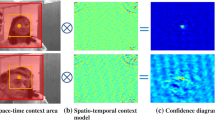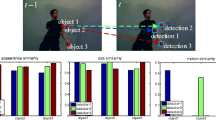Abstract
Built upon the methodology of “spatio-temporal context”, a simple yet robust object tracking method is proposed for solving the occlusion problems in this paper. This algorithm makes full use of the context information of the object and its local background to calculate the features, which maximumlly improve the occlusion predictive response and recapture accuracy. Firstly, an early warning mechanism is adopted to realize the occlusion detection. Once the object is fully occluded, the object position with accurate motion information saved in the early warning is predicted and memory tracking model is used to delete the suspected object region, which reduces the matching complexity. Finally, a confidence strategy for similarity measurement is adopted to capture the suspected object when the object appears, and the optimal confidence is introduced to get an adaptive update model. Many simulation experiments in benchmark videos show that our proposed algorithm achieves more favorable performance than these existing state-of-the-art algorithms.







Similar content being viewed by others
References
Bay H, Tuytelaars T, Van Gool L, et al. (2006) SURF: speeded up robust features[C]. European Conference on Computer Vision, 404–417
Chen X, Davis J (2008) An occlusion metric for selecting robust camera configurations. machine vision applications 19. 4 217–222.
Cui J, Liu Y, Xu Y, Zhao H, Zha H (2013) Tracking generic human motion via fusion of low- and high-dimensional approaches. IEEE Trans Syst Man Cybern B 43(4):996–1002
Henriques J, Caseiro R, Martins P, Batista J (2012) Exploiting the circulant structure of tracking-by-detection with kernels. In: ECCV. pp. 702–715 16
Henriques JF, Caseiro R, Martins P et al (2015) High-Speed Tracking with Kernelized Correlation Filters[J]. IEEE Trans Pattern Anal Mach Intell 37(3):583–596
Jiang H, Li J, Wang D et al. (2016) Multi-feature tracking via adaptive weights[J]. Neurocomputing, 189–201
Jun K, Min J, Xiao-Wei T, Yi-Ning S, Ke J, Guang-Rui W (2015) Target tracking by compressive sensing based on Gaussian differential graph[J]. J Infrared Millimeter Waves 34(1):100–105
Kalal, M, Matas, (2011) Tracking Learning Detection, Pattern Analysis and Machine Intelligence
Kalal Z, Matas J, Mikolajczyk K (2010) Pn learning: Bootstrapping binary classifiers by structural constraints. In: CVPR. pp. 49–56
Liu, Ye et al. Fusion of low-and high-dimensional approaches by trackers sampling for generic human motion tracking. International Conference on Pattern Recognition IEEE, 2012:898–901
Liu Y et al. (2015) Action2Activity: recognizing complex activities from sensor data. International Conference on Artificial Intelligence AAAI Press, 1617–1623
Liu Y et al (2016) From action to activity: Sensor-based activity recognition. Neurocomputing 181:108–115
Liu L, Cheng L, Liu Y et al. (2016) Recognizing Complex Activities by a Probabilistic Interval-Based Model[C]// Thirtieth AAAI Conference on Artificial Intelligence. AAAI Press, 1266–1272
Lowe DG (2004) Distinctive Image Features from Scale-Invariant Keypoints[J]. Int J Comput Vis 60(2):91–110
Ross DA, Lim J, Lin R, et al. (2008) Incremental Learning for Robust Visual Tracking [J]. International Journal of Computer Vision, 125–141
Ross D, Lim J, Lin R, Yang MH (2008) Incremental learning for robust visual tracking. IJCV 77(1):125–141
Su Z, Yuming Z, Liang H (2017) A multi-feature compressed target tracking algorithm based on redundant dictionary [J]. Acta Tribune of China 38(06):1140–1146
Tao XIE, Ensi WU (2017) A Robust Kernelized Correlation Tracking Algorithm for Infrared Targets Based on Ensemble Learning. JEIT 40(3):602–609
Torr HS (2011) Struck: Structured output tracking with kernels. In: ICCV. pp. 263–270
Valmadre J et al. (2017) End-to-End Representation Learning for Correlation Filter Based Tracking. computer vision and pattern recognition 5000–5008
Wen L, Cai Z, Lei Z, Yi D, Li S (2012) Online spatio-temporal structure context learning for visual tracking. In: ECCV. pp. 716–729
Wu Y et al. (2017) Nondestructive measurement of internal quality attributes of apple fruit by using NIR spectroscopy. Multimed Tools Appl 1–17
Yang C, Yu C, Yan M, Yuan X et al (2016) A Particle Filter Infrared Target Tracking Algorithm Based on Feature Fusion[J]. Inf Technol 38(03):211–217
Zhang KH, Song HH (2013) Real-time visual tracking Via online weighted multiple instance learning[J]. Pattern Recogn 46(1):397–411
Zhang KH, Zhang L, Yang MH et al (2013) Robust object tracking via active feature selection[J]. IEEE Trans Circuits syst Video Technol 23(11):1957–1967
Zhang KH, Zhang L, Yang MH (2013) Real-time object tracking via online discriminative feature selection[J]. IEEE Trans Image Process 22(12):4664–4677
Zhang KH, Zhang L, Yank MH (2014) Fast compressive tracking[J]. IEEE Trans Pattern Anal Mach Intell 36(10):2002–2015
Zhang KH, Zhang L, Liu Q S, et al. (2014) Fast visual tracking via dense spatio-temporal context learning[C]//European Conference on Computer Vision, 127–141
Zhang K, Zhang L, Yang M et al (2014) Fast Compressive Tracking.[J]. IEEE Trans Pattern Anal Mach Intell 36(10):2002–2015
Acknowledgements
This work was supported by the National Natural Science Foundation of Shanxi Province (No.2014021022-5), and the Technological Project of State Grid Corporation of China (No.5205301500). The authors thank Zhang Kaihua and Kalal for providing their results.
Author information
Authors and Affiliations
Corresponding author
Additional information
Publisher’s Note
Springer Nature remains neutral with regard to jurisdictional claims in published maps and institutional affiliations.
Rights and permissions
About this article
Cite this article
Tian, X., Li, H. & Deng, H. Object Tracking Algorithm based on Improved Context Model in Combination with Detection Mechanism for Suspected Objects . Multimed Tools Appl 78, 16907–16922 (2019). https://doi.org/10.1007/s11042-018-7025-y
Received:
Revised:
Accepted:
Published:
Issue Date:
DOI: https://doi.org/10.1007/s11042-018-7025-y




